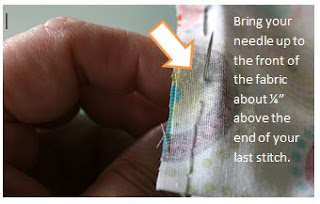 |
My Buds Bag, one of several I
have designed that function
much better with a lining. |
Here's a tutorial I wrote for ILikeCrochet.com several years back. I have reprinted it in my A La Maison 2 e-book, but just recently focused on the fact that I have not put it up here on the blog. Well, I am now taking care of that oversight.
**************************************************************
I am the anti-sewer.
Really. Yet, I appreciate the structural as well as aesthetic value of a well-made
and well-placed seam. Additionally, I love to design, make, and use bags, many
of which benefit from a fabric lining.
So, for all of you crafty folk out there in to the same
anti-sewing camp as me, this quick tutorial on how to create a bag lining will,
I hope, speak your language. If you’ve ever constructed a crocheted garment and
seamed it with a back stitch or whip stitch, or put together a motif-based
blanket, you’ve already got most of the bag-lining basics in your crafty
techniques toolbox.
Initially, lining your crochet bag project serves a few
important purposes: (1) it will provide additional support and safeguards to
the seams in your crochet fabric; (2) depending on the stitch pattern of your
crochet fabric, it will allow you the ability to carry small things in your bag
without fear of losing them; and (3) it will provide additional aesthetic value
to your handiwork.
In the Buds Bag design used for illustration purposes, I used
store-bought fabric. Don’t, however, limit yourself to fabric bolts. Bag
linings are a great way to re-use/upcycle all kinds of fabric bits around your
house: an old fabric pillow covering, silk, cotton and/or polyester blouses
that perhaps have seen better days or no longer fit, pajamas (especially silk
or polyester), and of course old jeans (assuming they contain a section big
enough for a lining that is hole-free).
Once you’ve identified your fabric source and have completed the crocheted portion of your bag, creating the lining is fairly
straightforward. I am using an easy rectangular-shaped bag as my example – if
you have a more complicated bag shape then some further effort may be
necessary.
1. Cut your fabric to
your bag’s dimensions, adding an additional ¾” in width and ½” in length. The
additional width will allow for ¼” seams on each side plus some additional ease
to allow for your crochet fabric to slightly stretch, as well as a generous ½”
seam allowance at the top. The fabric lining’s job is to reinforce your crochet
bag’s structure, but the crochet fabric is always responsible for the shape of
the bag. Items should rest within the shape of the crochet fabric with the
lining filling all of the bag’s shape with no gaps. While I measured my fabric
with ruler and pencil, you can also place your bag on the fabric and trace its
outline, allowing for the above-mentioned additional width and length.
 |
Above: measuring fabric; at right:
the cut fabric. Note
the bottom is
actually the fabric’s fold line.
|

2. Once your lining is cut, turn wrong side out and
pin your side seams ¼” from each side edge.
3. Alright, here’s where you’ll need to start
sewing – however, think of this as seaming two motifs together, because the
principle is basically the same. Thread
your needle with thread and knot the end; then, start at the bottom of one side
and work a back stitch seam, following the line of your pins.
4. Once you have seamed both sides of your fabric,
turn the lining right side out, turn
your crochet bag fabric wrong side out, and
slip your lining over the crochet fabric.
5. Now, you have just one more bit of sewing to go: the top edge seam. Turn the top of your lining fabric in, between the wrong side of the lining and the crochet bag, aligning it with one of the top rows of your crochet bag. For the Buds Bag, I lined the fabric up with the bottom of the reverse single crochet edging row.
6. Thread your needle and seam your lining to the crochet
fabric with a stitch whose mechanics are similar to a whip stitch – place your
needle from back to front of the crochet row and then back to front of the lining
fabric, keeping as close to the top of the lining fabric edge as possible.
7. Once you remove the straight pins, you’ll have a
seam that is surprisingly invisible.
8. Then turn your bag
right side out, add any handles and/or closing notions necessary, and then
admire your tremendous handiwork.
I hope this little tutorial will be helpful. Now get out those hooks and whip up some fun bags, complete with nifty linings, all for your very self.














